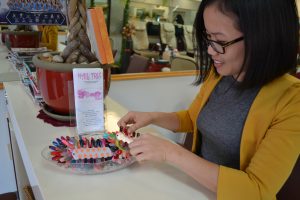By Leah Asmelash
At 4 a.m., the streets of downtown Durham, N.C. are eerie. The miscellaneous people who roam the streets during the day — construction workers, the homeless and businesspeople — are gone, leaving only darkness and silence.
The windows of Loaf, a bread bakery on the corner of Parrish Street, are the only source of light this early in the morning. Peering through the one of the two large, square windows, I see a short young woman walking around and setting up equipment. A teal headband holds her short brown hair in place. She wears a clean, white apron over her knit sweater and red and black plaid skirt. This is Maggie Payne, one of the morning bakers at Loaf. I am exhausted, but she holds a large teacup in her hands and appears well-rested, ready to bake.
As she explains her job to me, a man wheels a black bike into the bakery. Maggie greets him and tells me this is Brian Avery, the other morning baker. He flashes me a smile but says nothing, and I will soon realize this quietness is the norm for him. He’s tall and thin with a shock of brown hair. I later learn he rides his bike to Loaf every morning, a custom that takes him about 15 minutes.
Ron Graff opened Loaf in 2011 after four years of selling hearth breads at the Durham Farmers’ Market. Now, the bakery has been featured in Bon Appétit and The New York Times and is among the most popular bakeries in the Triangle.
A Baker’s Routine
It’s a small space, one reminiscent of a hole-in-the-wall bookstore rather than a full-fledged bakery. During the day, the sun streams through the two windows behind the front counter, illuminating the entire space with natural light and highlighting the two pastry cases on display — one filled with croissants, pain au chocolats and danishes, the other filled with tiny cakes and cream puffs. Behind the cases and against the window is the metal bread rack, displaying the breads of the day for purchase, like Market Loaf, Pain de Campagne and Polenta bread. In the back, separated from the front part of the store by a short hallway, is the kitchen where everything is baked.
Loaf’s kitchen is about the size of a small classroom, but the industrial baking equipment makes the space feel even more cramped. There’s a giant wood-fired oven in the back corner, and pushed next to it are four conventional ovens, stacked one on top of the other like a bookshelf. A long table completely covered with a wooden cutting board stretches across the middle of the room. On the right, there are sinks and a small work area next to an industrial stand mixer, and both a walk-in fridge and normal fridge to the left.
Maggie and Brian immediately get to work, Brian slams whole wheat and white croissant dough onto the floured cutting board table, while Maggie quietly melts butter over a plug-in stove top. They don’t speak this early, and the only noise, aside from Brian beating the dough, is the buzz from the large cooler in the front of the bakery.
Brian rolls out each fat rectangle of dough and after beating it, flattens it with a rolling pin. The muscles in his forearms clench with each roll, and he meticulously measures the now thin rectangle to ensure it’s the right size. There’s no guesswork involved here, only precision.
He cuts the dough into squares and lays strips of ham across them. He then tubes a soft cheese mixture across the slices of ham, working quickly and efficiently. On the last one, he makes a tiny mistake and the cheese doesn’t fall exactly where he wanted it to. He quickly smacks his lips and lets out a short sigh before he moves on to finish the pastries.
At this point, Brian has only been in the shop for half an hour, but he already has 30 ham and cheese croissants ready for proofing.
He makes a pot of coffee and offers me some. I notice he drinks it black and slow, only a few sips every 45 minutes. It seems at first that Brian has a cold personality, but I soon realize he just doesn’t talk much. When I start asking questions, he opens up easily.
“I was hoping to have strawberries,” he tells me, now hard at work on apricot danishes. “But we can do that tomorrow.”
He smiles as he speaks, and it’s shy, but warm and genuine. When he works, he is completely focused on whatever he does, whether it’s making coffee or prepping breakfast pastries for the day.
Passion Over Practicality
Meanwhile, Maggie is almost the complete opposite of Brian. For the most part, Brian stays in one place while prepping the pastries, but Maggie is constantly moving — fluttering between the stand mixer and the plug-in stove, juggling multiple tasks at once. She adds butter and milk to the stand mixer for hot cross buns, while melting chocolate on the burner for chocolate éclairs. As she works, she narrates everything to me.
Maggie started baking in high school, ultimately deciding to forego college to pursue a baking career. While in high school, she interned for a woman who made wedding cakes before working at a bakery called Lady Cakes, which is now closed. She considered attending culinary school and spent a year after high school researching the path, but she decided it was too expensive, especially in Durham where so many bakers were willing to take her under their wings.
Her parents were supportive of her pursuing baking rather than school, since it was a craft she loved. Maggie hopes to attend college to study science, but for now she enjoys working at Loaf and plans to remain there for the foreseeable future.
“I really enjoy it,” Maggie says. “Even if I don’t feel like going to work, I still enjoy it.”
It’s clear that she does, her quiet contentment on display every time she starts a pastry. She measures out vanilla extract in a bottle cap and pipes whipped chocolate hazelnut cream to make chocolate hazelnut cream puffs, a last-minute decision that she makes look effortless. The finished cream puffs look like tiny castles, and they glow underneath the pasty case lights, almost too pretty to eat.
In Sync
“I was hoping to make strawberry cream puffs,” she tells me, reflecting what Brian said earlier about the danishes. The two are in sync.
Brian and Maggie don’t talk much and when they do, it’s about work: what ingredients they have or don’t have or what they need to make. Brian gives some direction, but they both have the freedom to essentially do or make whatever they want. As they work, they mostly listen to podcasts and indie music, which Brian plays by connecting his phone to a speaker.
Despite their general silence, they’re engaged in a continuous dance as they go about their shift. Maggie shimmies by Brian as she shuffles to the other side of the kitchen, and he slides by her to get to the back. They work around each other, but somehow never seem to intrude or get in the other’s way.
They’re in harmony, as if they don’t need to communicate. Maggie pulls out the danishes Brian made earlier, spooning cream into the center and topping them with the apricot slices he prepped beforehand. She sprays the proofed ham and cheese croissants from hours earlier with water and tops them with extra cheese. At no point does Brian tell her to do these things, Maggie just knows.
That kind of knowing comes from years of working together. Maggie has been at Loaf for two years now and Brian for six, since the bakery opened its downtown location.
Restaurant Fatigue
Brian started as a line cook at Piedmont, a modern American restaurant in downtown Durham. But he was bored just being a line cook, so eventually he moved up and became the restaurant’s pastry chef, having previously been a baker at Wellspring, a Durham grocery store that is now a Whole Foods.
He met Ron when he was still only selling bread at the Durham Farmers’ Market. Brian discovered he was going to open up a bakery and decided to join.
“I was getting pretty tired of the restaurant business,” Brian said. Bakeries seemed calmer, which appealed to him.
Brian cleans out the wood-fired oven, where Loaf bakes almost all of the bread they sell, sweeping out the ash. Loaves of dough in small straw baskets are lined up on giant, stacked metal cooling racks. He scoops six loaves onto a peel, guiding them into shape using his palms. His touch is gentle but quick. He cuts lines into the tops of loaves using a metal lame, which he holds between his lips while he slides the loaves into the 500-degree wood-fired oven. He repeats this process for about five different types of bread, baking what seems to be hundreds of loaves in total, but the number is probably closer to 50. I don’t see him take a break.
Loaf’s Leader
Around noon, Ron makes his first appearance in Loaf. He’s tall, and his gray hair is pulled back into a braid that falls between his shoulder blades. His double piercings in his left ear sparkle under the light – one silver hoop and one teal stud.
The first thing he does is wash dishes. Ownership doesn’t give him a free pass.
We talk upstairs in a wide room overlooking Parrish Street. It’s a space Ron is still deciding what to do with, but for now serves as a temporary office and storage area.
Ron’s demeanor is lighthearted, and he jokes around with the staff and customers who come in. But when we start talking about Loaf, his tone grows more serious.
For him, Loaf was always about bread. He recognizes that croissants and pain au chocolats may pay the bills, and he’s glad that Loaf is known for those items too, but that isn’t what Loaf was meant to be.
“Bread is why most of us are here,” he says.
Bread was his passion, what he turned to when his day job, a research scientist at the University of North Carolina at Chapel Hill, became stressful. He didn’t set out to open a bakery, but as demand for his bread grew, he decided to find a space to bake full time.
A Community Bakery
Loaf is now what Ron calls a community bakery. He works nourish and feed the Triangle with his bread. Loaf donates any leftovers they have to refugee and homeless organizations, and they sell at two farmers’ markets, both Durham’s and Chapel Hill’s, all of which help increase their presence in the community.
Although Loaf didn’t begin with this intention, the bakery has become a way for Ron to give back to his community.
He stares out the window, looking down on Parrish Street. It’s the middle of the day now, so the construction workers have returned and people are roaming the streets.
“I want to be a good citizen,” he says.
Back in the kitchen, the originally quiet space is now filled with chatter and laughter. Music underlines all the action as Maggie tells jokes that make the other bakers laugh. Everyone is still working, but it’s clear they’re all friends, part of the same community.
The only one who doesn’t talk is Brian, who’s completely focused on his bread, one hand on his hip and the other resting on the door of the wood-fired oven. Although he has separated himself from the group, he still waves at passing customers he recognizes. He’s part of Loaf, part of this community bakery that continues to flourish, both in and outside the kitchen.
Edited by Sarah Muzzillo


